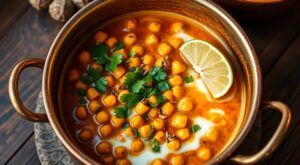A classic Southern dish that’s both sweet and savory, pineapple casserole has become a staple at holiday gatherings. You might be wondering, what’s the secret to its irresistible appeal?
The unique combination of juicy pineapple chunks, sharp cheddar cheese, and a buttery cracker topping creates a delightful contrast of textures and flavors. This casserole recipe has been a favorite at Easter and Thanksgiving dinners for generations.
To achieve the perfect bake, it’s crucial to get the timing right. Too little, and the crust is undercooked; too much, and it’s burnt. In this guide, we’ll walk you through mastering the ideal bake time for a flawless pineapple casserole.
Key Takeaways
- Understand the origins and appeal of pineapple casserole.
- Learn the essential components of a classic pineapple casserole recipe.
- Discover tips for achieving the perfect bake time.
- Explore variations to suit different tastes and dietary needs.
- Master the technique for a golden-brown crust and perfectly cooked filling.
The Southern Charm of Pineapple Casserole
The pineapple casserole has become a staple in Southern cuisine, embodying a unique blend of sweet and savory flavors. This dish has a rich history, dating back to the 1950s when Southern home cooks first discovered the delightful combination of pineapple and cheese.
A Unique Sweet and Savory Tradition
The pineapple casserole exemplifies the Southern tradition of transforming simple pantry staples into something extraordinary. It’s a dish that brings families together around the table, often gracing Thanksgiving and Easter tables alongside other traditional dishes.
Why This Unexpected Combination Works
The unexpected pairing of pineapple and cheese creates a flavor profile that complements traditional holiday meats, especially ham. This is why it became a staple at Easter and Thanksgiving gatherings. You’ll find variations of this recipe in countless community cookbooks throughout the South, with each family claiming their version as the definitive one.
| Characteristics | Description |
|---|---|
| Emergence | Pineapple casserole emerged in the 1950s |
| Main Ingredients | Pineapple, cheese, and Ritz crackers |
| Occasions | Thanksgiving, Easter, and family gatherings |
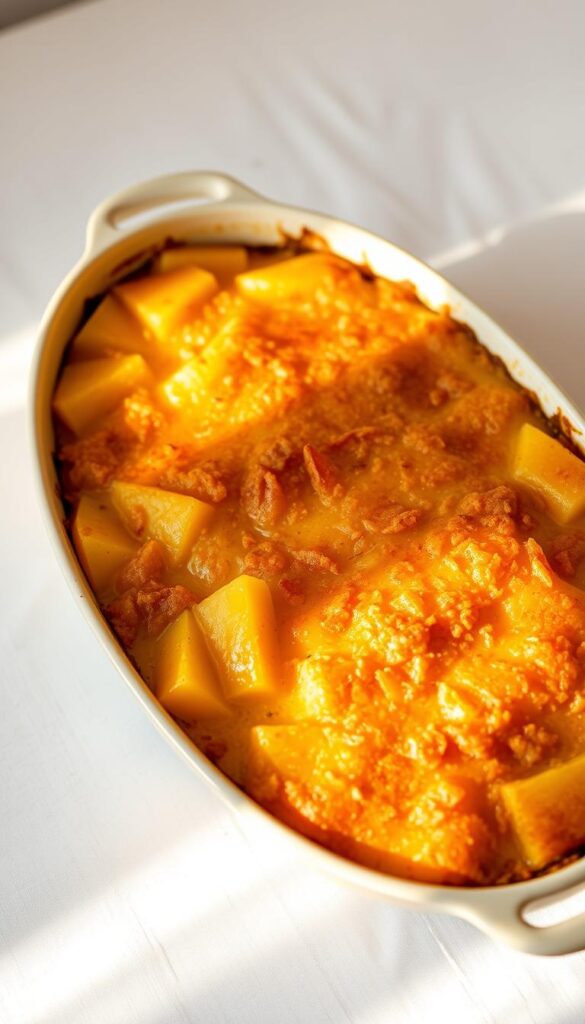
The pineapple casserole has become so iconic that it’s even featured on South Carolina’s tourism website as a representation of authentic Southern cuisine. While it might raise eyebrows for those unfamiliar with Southern cooking traditions, one taste is usually enough to convert skeptics into devoted fans.
Essential Ingredients for Perfect Pineapple Casserole
To make a truly exceptional pineapple casserole, you need to start with the right ingredients. The quality of these components directly impacts the final product’s taste and texture.
Pineapple Options: Chunks, Tidbits, or Crushed
The type of pineapple you choose forms the foundation of your casserole. You can use canned pineapple chunks, tidbits, or crushed pineapple depending on your texture preference. While canned pineapple is traditional and convenient, you can substitute fresh pineapple (about 4-5 cups) if you prefer.
The Cheese Factor: Why Sharp Cheddar Works Best
Sharp cheddar cheese is essential as it provides a savory counterpoint to the sweet pineapple and creates a creamy texture throughout the casserole. Grate the cheddar cheese yourself for the best results.
The Importance of Ritz Crackers
Ritz crackers are a crucial ingredient, not just a topping. Their buttery flavor and delicate texture provide a perfect counterbalance to the sweet pineapple filling. Substituting another cracker won’t yield the same results.
| Ingredient | Purpose |
|---|---|
| Pineapple | Foundation of the casserole |
| Sharp Cheddar Cheese | Savory counterpoint and creamy texture |
| Ritz Crackers | Buttery flavor and texture contrast |
Preparing Your Pineapple Casserole Bake Take
The key to a perfect pineapple casserole lies in its preparation. To achieve this, you’ll need to focus on a few crucial steps that will ensure your casserole turns out delicious and satisfying.
Draining and Reserving Pineapple Juice
Start by draining your pineapple, but be sure to reserve some of the pineapple juice for later use. This juice adds moisture and intensifies the flavor in your casserole. Any extra juice can be frozen for future use in marinades or cocktails.
Creating the Perfect Sugar-Flour Base
Mixing the sugar and flour properly is crucial. This base will thicken the pineapple mixture during baking, preventing a watery casserole. Ensure the sugar and flour are well incorporated with the fruit.
Properly Crushing Crackers for the Topping
To create the perfect topping, cracker crumbs should vary in size. Place crackers in a zip-top bag and gently break them up until you have a mix of small and medium pieces. This technique aids in crunchiness and allows the melted butter to be absorbed properly.
| Preparation Step | Importance |
|---|---|
| Draining Pineapple | Reserves juice for added moisture |
| Sugar-Flour Base | Thickens pineapple mixture |
| Crushing Crackers | Creates crunchy topping |
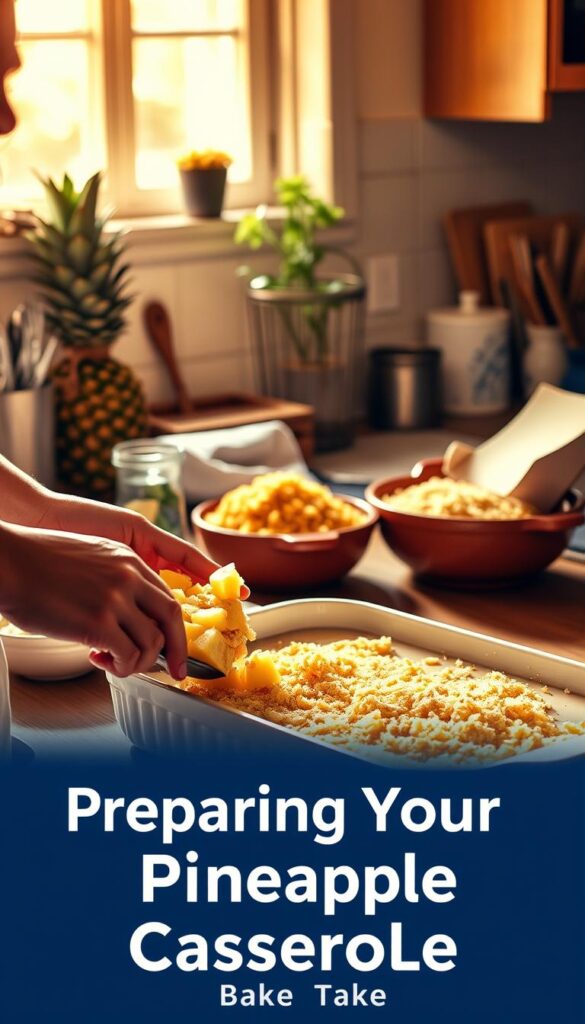
Mastering the Bake Time for Pineapple Casserole
Achieving the perfect bake for your pineapple casserole is a delicate balance of temperature and timing. To ensure your dish turns out perfectly, follow these guidelines.
The Ideal Temperature: 350°F
Preheating your oven to 350°F is crucial. This temperature allows for even cooking without burning the cracker topping. Always preheat your oven completely before inserting your casserole to ensure consistent baking from start to finish.
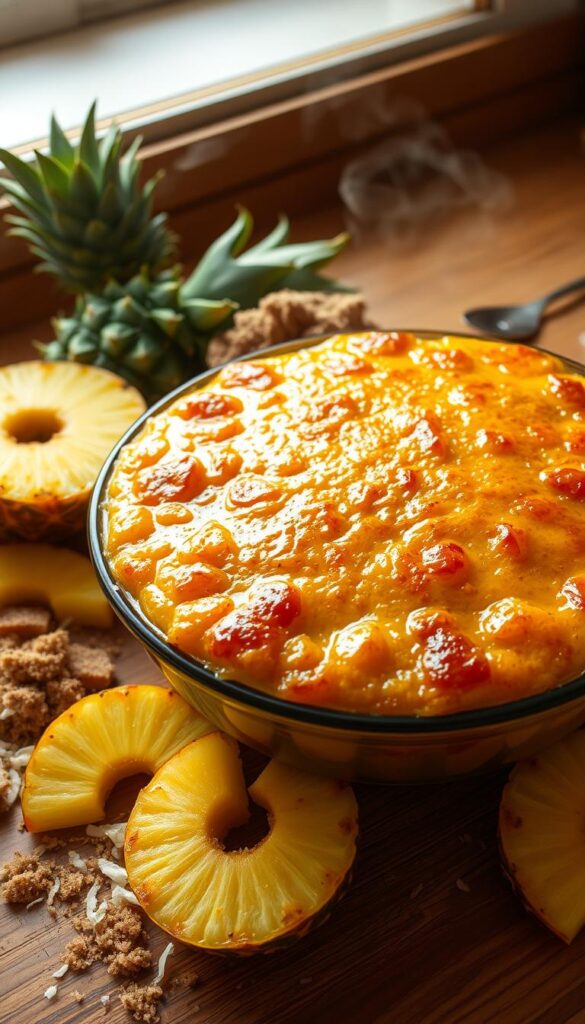
How to Tell When Your Casserole Is Perfectly Baked
Visual cues are your best guide for perfect doneness. Look for a golden brown cracker topping and bubbling around the edges of the casserole. The standard bake time for a 9×13-inch baking dish is approximately 25-30 minutes.
Adjusting Bake Time for Different Dish Sizes
If you’re using a deeper dish, like an 8×8-inch square, you may need to extend the baking time by 5-10 minutes. Conversely, a thinner layer in a larger dish might require a slightly reduced baking time to prevent over-browning.
| Dish Size | Bake Time |
|---|---|
| 9×13 inches | 25-30 minutes |
| 8×8 inches | 30-40 minutes |
For the most even baking, position your casserole dish in the center of the oven. Let it rest for 5-10 minutes after baking to allow the sugars to set.
Recipe Variations and Customizations
Pineapple casserole is a versatile dish that can be tailored to your taste preferences. You can experiment with different ingredients to create a unique flavor profile that suits your needs.
Brown Sugar vs. White Sugar
Switching from white sugar to brown sugar adds depth and a subtle molasses flavor that complements the pineapple beautifully. For a lighter version, you can reduce the sugar to 1/2 cup and the butter to 1/4 cup, which cuts down on fat while maintaining the essential flavor profile.
Adding Cinnamon and Nutmeg for Extra Flavor
Adding warm spices like cinnamon and nutmeg to the cracker topping creates a more complex flavor that’s especially appealing during holiday seasons.
Fresh Pineapple Substitution Tips
When substituting fresh pineapple for canned, you’ll need about 4-5 cups of fresh pineapple chunks and will need to add about 1/4 cup of pineapple juice or water to compensate for the missing canned juice. Mixing crushed pineapple with pineapple tidbits creates an interesting texture variation.
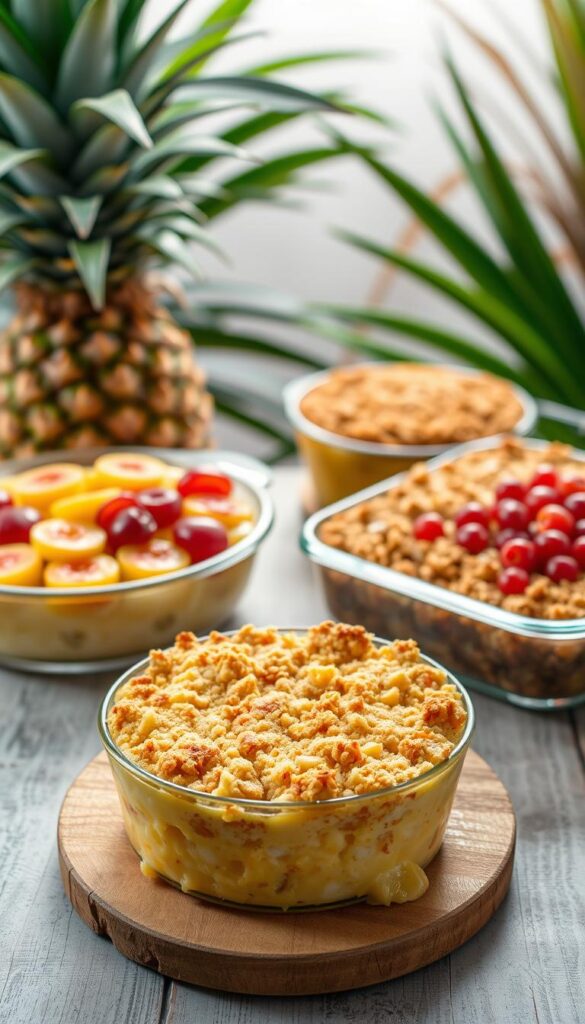
You can also add a tropical twist by mixing in shredded coconut or complementary fruits like diced mango or peaches into the pineapple layer. Adjusting the amount of butter and sugar to your taste can also make a big difference in the final product.
Serving Suggestions for Pineapple Casserole
When it comes to serving pineapple casserole, the possibilities are endless. You can enjoy this delightful dish at various holiday gatherings, and it pairs perfectly with your holiday ham or Thanksgiving turkey.
Perfect Pairings with Holiday Ham
Pineapple casserole shines brightest when served alongside a holiday ham, as the sweet-savory flavor complements the saltiness of the meat perfectly. It’s also a wonderful addition to your Easter dinner, where ham and pineapple become the perfect pairing.
From Side Dish to Dessert: Versatile Serving Options
This versatile casserole can be served hot as a side dish at dinner or at room temperature as a sweet ending to the meal, blurring the line between side and dessert. For Thanksgiving, place this casserole among your savory sides for a surprising counterpoint to traditional dishes.
Make-Ahead and Reheating Tips
You can prepare this pineapple casserole recipe up to 24 hours in advance by assembling everything except the cracker topping with melted butter, which should be added just before baking. Leftovers will keep well in the refrigerator for up to 4 days when stored in an airtight container. To reheat, cover with foil and warm in a 300°F oven until heated through, or microwave individual portions for 1-2 minutes. For a beautiful presentation, sprinkle a little fresh parsley on top of the golden casserole.
FAQ
What type of pineapple is best for this casserole recipe?
You can use canned crushed or tidbits for this recipe. Both work well, and it’s up to your personal preference. Make sure to drain the juice and reserve it for later use.
Can I use a different type of cheese instead of sharp cheddar?
While sharp cheddar is recommended, you can experiment with other cheeses. However, keep in mind that sharp cheddar provides a unique flavor profile that complements the sweetness of the pineapple.
How do I properly crush Ritz crackers for the topping?
To crush Ritz crackers, place them in a plastic bag and use a rolling pin to crush them into fine crumbs. You can also use a food processor, but be careful not to overprocess.
Can I prepare the casserole ahead of time?
Yes, you can prepare the casserole a day in advance. Simply assemble the dish, cover it with plastic wrap, and refrigerate. Bake it when you’re ready, adjusting the bake time as needed.
How do I know when the casserole is perfectly baked?
The casserole is done when it’s golden brown on top and the filling is bubbly. Check it after 30 minutes, and continue baking in 5-minute increments until it reaches your desired level of browning.
Can I use fresh pineapple instead of canned?
While canned pineapple is recommended, you can use fresh pineapple as a substitute. However, you’ll need to adjust the amount of sugar and juice accordingly. Fresh pineapple can be more dense and sweet, so keep that in mind when making adjustments.


